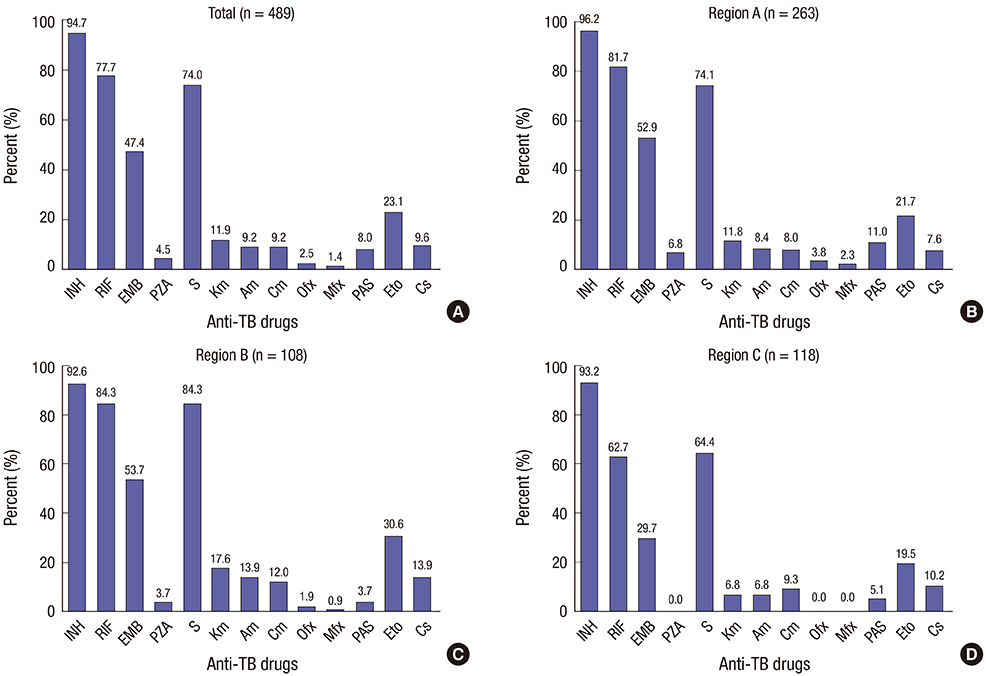J Korean Med Sci.
2017 Jul;32(7):1105-1110. 10.3346/jkms.2017.32.7.1105.
Characteristics of Drug Resistant Tuberculosis in Sanatoria of North Korea
- Affiliations
-
- 1Clinical Research Center, Masan National Tuberculosis Hospital, Changwon, Korea. paratb@gmail.com
- 2Department of Internal Medicine, Ulsan University Hospital, University of Ulsan College of Medicine, Ulsan, Korea.
- 3Department of Cancer Control and Population Health, Graduate School of Cancer Science and Policy, National Cancer Center, Goyang, Korea.
- 4Department of Preventive Medicine, Hanyang University College of Medicine, Seoul, Korea.
- 5Department of Pulmonary and Critical Care Medicine, Asan Medical Center, University of Ulsan College of Medicine, Seoul, Korea.
- KMID: 2379604
- DOI: http://doi.org/10.3346/jkms.2017.32.7.1105
Abstract
- Although several reports about drug-resistant tuberculosis (TB) in North Korea have been published, a nationwide surveillance on this disease remains to be performed. This study aims to analyze the drug resistance patterns of Mycobacterium tuberculosis among the patients in the sanatoria of North Korea, especially during the period when second-line drugs (SLDs) had not yet been officially supplied to this country. The Eugene Bell Foundation (EBF) transferred 947 sputum specimens obtained from 667 patients from 2007 to 2009 to the Clinical Research Center, Masan National Tuberculosis Hospital (MNTH), South Korea. Four hundred ninety-two patients were culture positive for TB (73.8%). Drug susceptibility test (DST) was performed for the bacilli isolated from 489 patients. Over 3 quarters of the cases (76.9%) were multidrug-resistant (MDR)-TB. Additionally, 2 patients had extremely drug-resistant (XDR)-TB. Very high resistance to first-line drugs and low resistance to fluoroquinolones (FQs) and injectable drugs (IDs) except for streptomycin (S) were detected. A small but significant regional variation in resistance pattern was observed. Big city regions had higher rate of MDR-TB, higher resistance to FQs and IDs than relatively isolated regions. In conclusion, significant number of drug-resistant TB was detected in North Korean sanatoria, and small but significant regional variations in resistance pattern were noticeable. However, the data in this study do not represent the nationwide drug resistance pattern in North Korea. Further large-scale evaluations are necessary to estimate the resistance pattern of TB in North Korea.
Keyword
MeSH Terms
Figure
Reference
-
1. World Health Organization. Global tuberculosis report 2015 [Internet]. accessed on 16 April 2016. Available at http://www.who.int/tb/publications/global_report/en/.2. World Health Organization. National tuberculosis control programme: democratic People's Republic of Korea [Internet]. accessed on 18 July 2016. Available at http://apps.searo.who.int/PDS_DOCS/B5159.pdf.3. Eugene Bell Foundation (KR). History of Eugene Bell Foundation [Internet]. accessed on 8 April 2016. Available at http://www.eugenebell.org/.4. Seung KJ, Linton SW. The growing problem of multidrug-resistant tuberculosis in North Korea. PLoS Med. 2013; 10:e1001486.5. Seung KJ, Franke M, Linton SW. Multidrug-resistant tuberculosis treatment in North Korea: is scale-up possible? PLoS Med. 2016; 13:e1002062.6. Pal N, Sharma B, Malhotra B, Rishi S. Transport and storage of sputum specimen by using cetylpyridinium chloride for isolation of mycobacteria. Indian J Pathol Microbiol. 2009; 52:59–61.7. Selvakumar N, Sekar MG, Ilampuranan KJ, Ponnuraja C, Narayanan PR. Increased detection by restaining of acid-fast bacilli in sputum samples transported in cetylpyridinium chloride solution. Int J Tuberc Lung Dis. 2005; 9:195–199.8. Selvakumar N, Sudhamathi S, Duraipandian M, Frieden TR, Narayanan PR. Reduced detection by Ziehl-Neelsen method of acid-fast bacilli in sputum samples preserved in cetylpyridinium chloride solution. Int J Tuberc Lung Dis. 2004; 8:248–252.9. World Health Organization. WHO publications on tuberculosis: laboratory services in tuberculosis control (part 3: culture) [Internet]. accessed on 15 May 2016. Available at http://www.who.int/tb/publications/who_tb_98_258/en/.10. World Health Organization. Treatment of tuberculosis: guidelines for national programmes. 3rd ed [Internet]. accessed on 16 July 2016. Available at http://library.health.go.ug/publications/service-delivery-diseases-control-prevention-communicable-diseases/tuberculosis-10.11. Lee HY, Lee J, Lee YS, Kim MY, Lee HK, Lee YM, Shin JH, Ko Y. Drug-resistance pattern of Mycobacterium tuberculosis strains from patients with pulmonary and extrapulmonary tuberculosis during 2006 to 2013 in a Korean tertiary medical center. Korean J Intern Med. 2015; 30:325–334.


